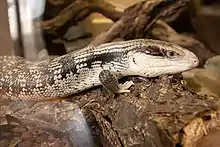Eastern blue-tongued lizard
The eastern blue-tongued lizard (Tiliqua scincoides scincoides) is a subspecies of large skink which is common throughout eastern Australia, often found in bushland and suburban areas where conditions are suitable. The lizard is known as blue-tongue because its tongue can range from bright to dark blue, and it has a habit of displaying it prominently and hissing loudly when disturbed.
| Eastern blue-tongued skink | |
|---|---|
 | |
| Scientific classification | |
| Kingdom: | Animalia |
| Phylum: | Chordata |
| Class: | Reptilia |
| Order: | Squamata |
| Family: | Scincidae |
| Genus: | Tiliqua |
| Species: | |
| Subspecies: | T. s. scincoides |
| Trinomial name | |
| Tiliqua scincoides scincoides | |
.jpg.webp)
The eastern blue-tongued skink is a stout and slow lizard with brown to grey scales and a barred pattern across the body and tail. The underside is usually pale. Blue-tongued lizards are popular as pets and can live up to 30 years in captivity. They give birth to live young, between six and a record 20 per litter. The young consume the egg sac immediately after birth. They resemble the adult form closely. Several other types of blue-tongued lizard are in the genus Tiliqua, such as the northern blue-tongued skink and the shingleback or stump-tailed skink.
This subspecies was first described as Lacerta scincoides, by the Irish surgeon and botanist John White.
References
External links
| Wikimedia Commons has media related to Tiliqua scincoides scincoides. |
| Wikispecies has information related to Tiliqua scincoides. |
- BlueTongueSkinks.net
- Blue-tongued skinks, Melissa Kaplan's Herp Care Collection
- Tiliqua scincoides , James Cook University